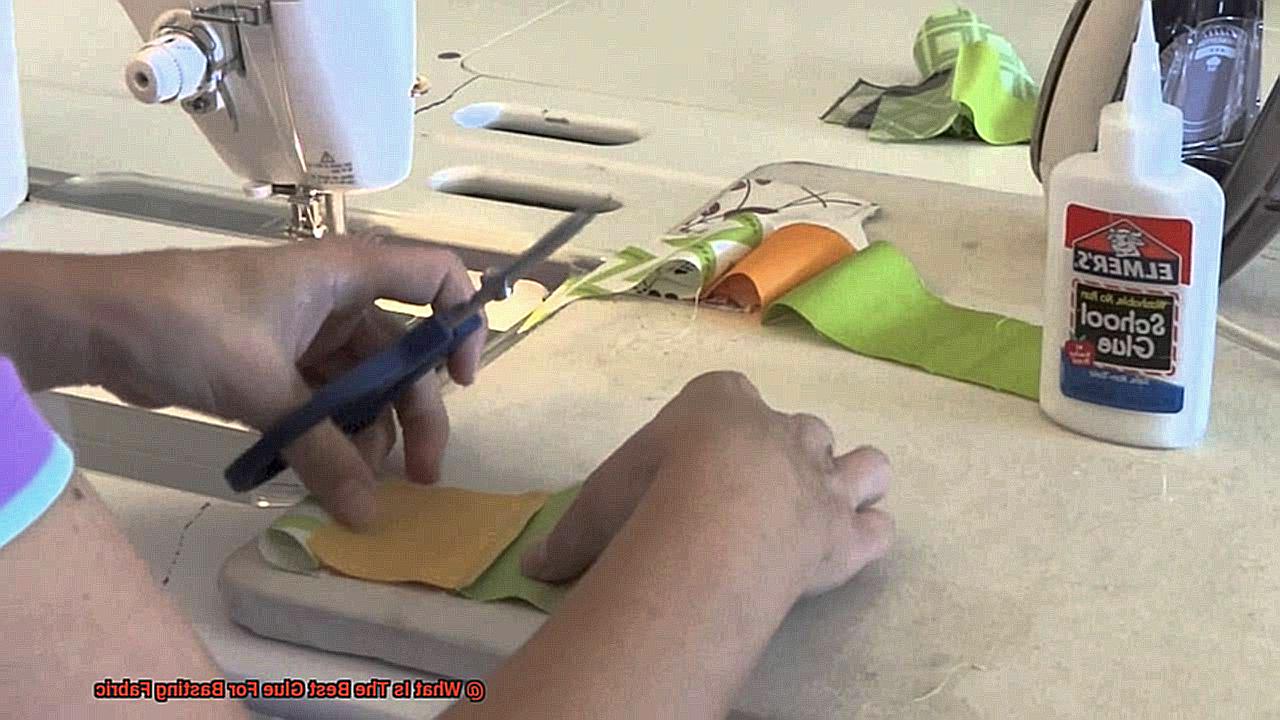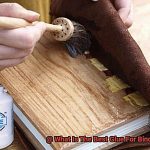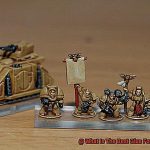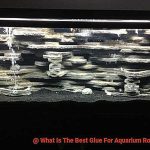Title: Unleash Your Crafting Potential with the Best Glue for Basting Fabric
Introduction:
Contents
- 1 Types of Glue for Basting Fabric
- 2 Benefits of Using Fabric Glue
- 3 Advantages of Washable Glue
- 4 Pros and Cons of Temporary Adhesive Sprays
- 5 Factors to Consider When Choosing the Best Glue for Basting Fabric
- 6 How to Test the Glue on a Small Area Before Applying It to the Entire Piece
- 7 Popular Brands of Glue for Basting Fabric
- 8 Conclusion
Are you tired of struggling to keep your fabric pieces in place while you work on your sewing projects? Well, I’ve got some exciting news for you. The secret to hassle-free basting lies in finding the perfect glue. And trust me, once you discover this game-changing adhesive, your crafting world will never be the same.
In this blog post, we’re diving headfirst into the mesmerizing realm of glue for basting fabric. We’ll be sharing insider tips, tricks, and recommendations from seasoned crafters who have mastered the art of adhesive selection. Get ready to embark on a journey that will revolutionize your sewing endeavors and leave you wondering how you ever survived without this ultimate glue solution.
So, are you ready to unravel the mystery behind flawless fabric basting? Buckle up and let’s dive right in.
Types of Glue for Basting Fabric
When it comes to basting fabric, choosing the right glue is essential for achieving accurate and secure temporary holds. In this comprehensive guide, we will explore the different types of glue specifically designed for basting fabric. Whether you’re working with delicate silk or sturdy denim, we’ve got you covered.
Water-Soluble Glue:
Water-soluble glues are a popular choice for basting delicate or lightweight fabrics like silk or chiffon. These glues are easy to apply and dry clear, making them ideal for temporary adhesion. After completing your basting stitches, simply wash away the glue with water, leaving no residue behind. It’s like magic.
Glue Sticks:
Glue sticks are another go-to option for basting fabric. They are easy to handle and provide a temporary bond that holds fabrics in place until the basting stitches are made. Non-toxic and washable, glue sticks are suitable for a wide range of fabric projects. Just choose a high-quality one to avoid residue or stains on your precious fabrics.
Spray Adhesives:
Looking for a quick and convenient way to baste fabric? Spray adhesives have got your back. These aerosol cans provide an even and fine mist of adhesive onto the fabric surface, creating a temporary bond until the basting stitches are made.
However, be cautious and select a spray adhesive specifically formulated for fabric to avoid permanent stains or damage.
Fusible Web:
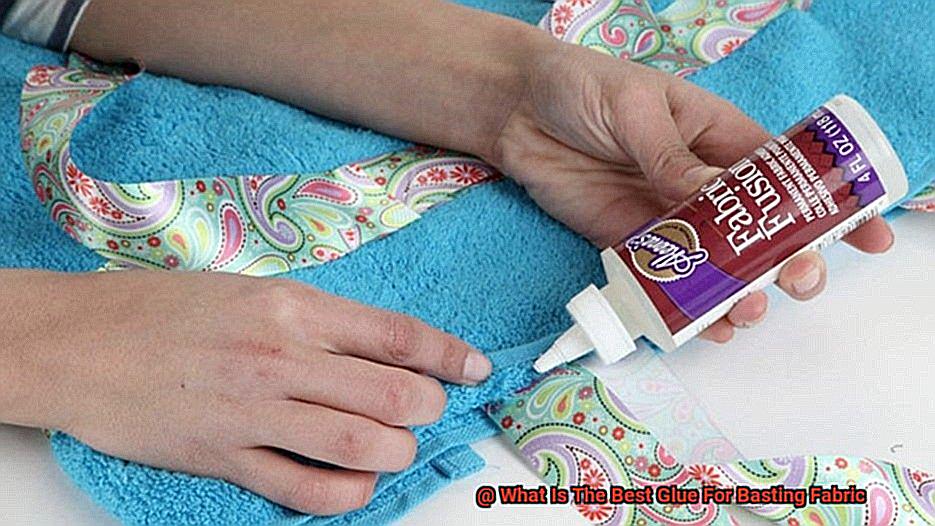
Fusible web is a heat-activated adhesive material available in sheets or rolls. It is perfect for basting fabric by applying it between layers and pressing them together with an iron. This adhesive provides a temporary hold until the basting stitches are made. Remember, fusible web may leave a residue and can affect the drape or feel of the fabric, so use it wisely.
Fabric Glue:
Specifically designed for bonding fabric, fabric glue is a versatile option for basting. It comes in liquid form and can be applied with a brush or nozzle. Fabric glue provides a temporary bond that holds the fabric in place until the basting stitches are made.
It dries clear and flexible, ensuring no visible marks or texture changes on your fabric. Just remember to use it sparingly to avoid stiffness or residue.
Now that you know about the different types of glue for basting fabric, you can confidently choose the perfect one for your project. Whether you opt for water-soluble glue, glue sticks, spray adhesives, fusible web, or fabric glue, each type has its unique properties and applications.
Benefits of Using Fabric Glue
Look no further. In this comprehensive guide, we will delve into the fantastic benefits of using fabric glue for basting. From saving time to achieving a flawless finish, fabric glue offers a myriad of advantages that make it an indispensable tool for both beginners and experienced sewers.
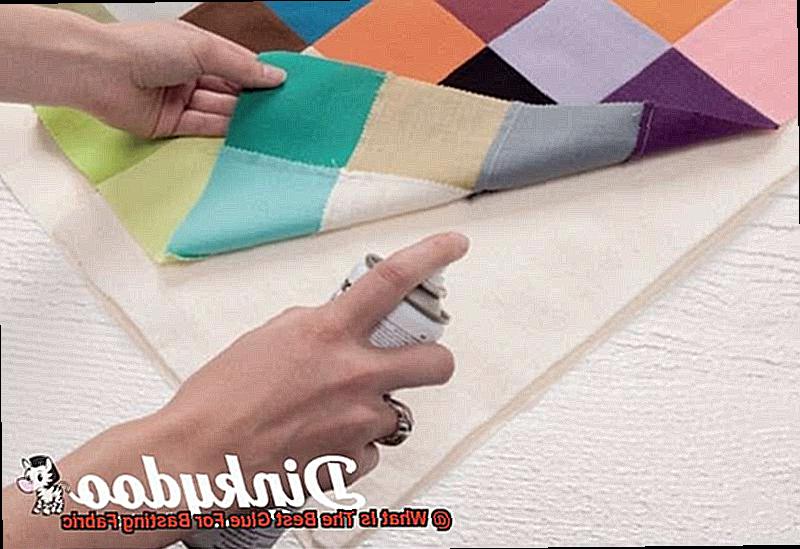
Time-Saving Convenience:
One of the most significant benefits of using fabric glue for basting is the time it saves. Unlike traditional hand-sewing methods that demand meticulous stitching, fabric glue allows you to quickly adhere fabric layers together. This is particularly advantageous when working on large projects or when time is limited.
Ease of Use:
Fabric glue is incredibly user-friendly, making it a perfect choice for beginners or those seeking a convenient alternative to sewing. With no special skills or equipment required, simply apply the glue to the desired areas, press the fabrics together, and let it dry. It’s as simple as that. This ease of use makes fabric glue accessible to everyone, regardless of their sewing experience.
Versatility:
Another advantage of fabric glue is its versatility. It can be used on various types of fabrics, including cotton, silk, denim, and even leather. This makes it an invaluable tool for a wide range of sewing and crafting projects. Whether you are altering clothing, repairing upholstery, or creating DIY home decor, fabric glue can effectively bond different fabrics together.
Invisible Bond and Professional Finish:
One unique advantage of using fabric glue is the invisible bond it creates between fabric layers. Unlike traditional sewing methods that leave visible stitches, fabric glue provides a seamless and professional-looking finish. This is particularly useful when working with delicate fabrics or when you want to achieve a clean and polished appearance.
Washable and Durable:
Many fabric glues are designed to be washable and durable, ensuring that your projects remain intact even after multiple machine washes. This is essential when working on garments or items that require regular washing or exposure to moisture. By using a high-quality fabric glue, you can have peace of mind knowing that your creations will withstand the test of time.
Temporary and Adjustable:
Fabric glue is an excellent choice for temporary basting or adjusting fabric placement before final stitching. Unlike permanent stitches, fabric glue allows you to easily reposition fabrics or make alterations without leaving visible marks. This makes it ideal for fitting adjustments or when you want to experiment with different design elements before committing to permanent stitching.
No Needle Marks:
One common issue with hand-sewing is the presence of needle marks on delicate fabrics. Fabric glue eliminates this problem entirely since it does not involve piercing the fabric with a needle. This is especially important when working with sheer or lightweight fabrics that can easily show marks or holes left by needles.
Advantages of Washable Glue
Well, let me introduce you to the game-changer – washable glue. Yes, you heard that right, glue can be your new best friend when it comes to basting fabric.
So, what exactly are the advantages of using washable glue for basting fabric? Let’s dive in and explore the many benefits it offers.
First and foremost, washable glue is incredibly versatile. It can be used on a wide range of fabrics, from cotton to silk and everything in between. With washable glue, you don’t have to worry about different glues for different projects – one glue fits all. This means less time spent searching for the right adhesive and more time spent on your creative endeavors.
Not only is washable glue versatile, but it also provides a strong hold. This is especially important when working with slippery or delicate fabrics that tend to slip and slide. With washable glue, your pieces will stay in place, ensuring accurate basting every time. No more frustration or wasted effort.
And let’s not forget about the ease of use. Washable glue typically comes in a bottle with a narrow tip, allowing for precise application. You can easily spread the glue along the edges or seams of your fabric, providing an even hold without any mess or fuss. It’s like having a magic wand that effortlessly holds everything together.
But what about those unsightly needle marks left behind by pins or thread? Say goodbye to them with washable glue. Unlike traditional basting methods, washable glue doesn’t leave any visible marks on your fabric. Once you’re done basting, simply wash away the glue and voila – no more marks. Your fabric will look pristine and ready for the next step.
Now, if you’re someone with allergies or sensitivities, washable glue is the way to go. It’s non-toxic and doesn’t emit strong odors like some other adhesives. So you can work on your projects without worrying about any adverse reactions. Breathe easy and enjoy the process of creating without any discomfort.
And here’s the cherry on top – removing washable glue is as easy as washing your fabric. Most washable glues dissolve in water, allowing them to wash away without leaving any residue behind. This means you can easily make adjustments or changes to your basted fabric without any hassle. No need to worry about ruining your project or starting from scratch if something doesn’t quite line up.
Pros and Cons of Temporary Adhesive Sprays
Temporary adhesive sprays are a game-changer when it comes to basting fabric. These magical cans offer a quick and easy solution for keeping your fabric layers in place. But before you start spraying, let’s take a closer look at the pros and cons of using these handy sprays.
Pros:
- Versatility: Temporary adhesive sprays can be used on a wide range of fabrics, from delicate silk to sturdy denim. No matter what type of project you’re working on, these sprays have got you covered.
- Time-saving: Say goodbye to time-consuming hand stitching or pinning. With temporary adhesive sprays, you can quickly and securely hold your fabric layers together, allowing you to dive right into your sewing without any worries.
- Precision: The even distribution of adhesive ensures that your fabric stays in place, preventing any shifting or distortion during sewing. This means no more puckering or wrinkling – just clean and professional-looking seams.
Cons:
- Overspray: One potential downside is the risk of overspray. This sticky situation can result in adhesive spreading beyond the intended area and making a mess. To avoid this, use masking tape or protective sheets to cover areas that should remain adhesive-free.
- Needle gumming: Another con to consider is the possibility of the adhesive transferring onto your needle or sewing machine during stitching. This can lead to gummed up needles and skipped stitches, which can be a real headache to fix. Clean your needle regularly and use adhesive sprays sparingly to minimize this risk.
- Sensitivities and allergies: Lastly, some people may have sensitivities or allergies to the chemicals present in temporary adhesive sprays. Read and follow the instructions carefully, and if you experience any adverse reactions, stop using the spray immediately.
Factors to Consider When Choosing the Best Glue for Basting Fabric
When it comes to choosing the best glue for basting fabric, there are several factors to consider. Let’s dive into this fascinating world and explore these factors together.
First and foremost, consider the type of fabric you’ll be working with. Different glues work better on different fabrics. Cotton, silk, satin – they all have different properties that require specific glues. So, take a moment to assess the fabric type before making your selection.
Next, think about the hold you need. Basting is a temporary stitching technique, so you want a glue that offers a temporary hold. Look for glues that are labeled as “temporary” or “fabric basting” glues. These will allow you to easily remove the glue without damaging your precious fabric.
Drying time is another crucial factor. You don’t want to waste time waiting for glue to dry. Look for a glue that dries quickly and securely, so you can keep working without unnecessary delays.
If your project involves washing, choose a washable glue. Nobody wants stiff fabric or adhesive that loses its stickiness after one wash. Look for glues that can withstand multiple washes without compromising their adhesive properties.
Aesthetics also play a role in glue selection. Transparent glues are great if you don’t want any visible residue on your fabric. However, colored glues can add an extra touch of style by matching or contrasting with your fabric.
Ease of application is key, especially if you’re new to basting or just not particularly fond of gluing things together. Look for glues with applicator tips or user-friendly packaging that make application precise and easy.
Nobody wants their creative process ruined by an unpleasant odor. Consider choosing a glue with low or no odor, especially if you’re sensitive to smells or planning to work on your project for an extended period.
Lastly, safety first. Always opt for non-toxic glues that adhere to safety standards. This is especially important when working on projects involving children or pets.
By considering these factors, you’ll be well-equipped to choose the best glue for basting fabric that suits your project’s specific requirements. Remember to follow the manufacturer’s instructions for proper application and usage.
How to Test the Glue on a Small Area Before Applying It to the Entire Piece
Before you dive into gluing your fabric project together, it’s crucial to test the glue on a small area first to ensure that it won’t cause any damage or staining. This simple step can save you from potential disasters and help you achieve the best results. Here’s how you can do it:
Step 1: Choose a Secret Spot
Select a small, inconspicuous area of your fabric piece where any potential damage or staining won’t be noticeable. This could be the hemline, an inside seam, or a hidden corner. It’s like finding a secret treasure spot. By testing on a discreet area, you can ensure that even if there are any negative effects, they won’t ruin the overall appearance of your project.
Step 2: Apply a Little Dab
Using a cotton swab or a small brush, apply a small amount of glue to the chosen spot. Be sure to follow the instructions provided by the glue manufacturer regarding the amount to use and the application method. Remember, less is more – you don’t want to drown your fabric in glue.
Step 3: Stick It Together
Gently press the fabric together where you applied the glue, ensuring that it is firmly bonded. Hold it in place for a few moments, as if giving it a little hug. This will allow the glue to bond with the fabric and create a strong connection.
Step 4: Wait for it…
Now comes the hard part – waiting. Let the glued area dry completely according to the manufacturer’s instructions. This may take anywhere from a few minutes to several hours, depending on the type of glue you are using. Patience is key – just like waiting for your favorite ice cream to freeze.
Step 5: Inspect and Protect
Once the glue is dry, take a close look at your secret spot. Examine the fabric for any discoloration, damage, or changes in texture. Gently touch and tug at the fabric around the glued area to check for any signs of adhesive residue or weakening. If everything looks good, then you’re ready to rock and roll. But if there are any signs of trouble, it’s time to pick another glue or find a different way to stick your fabric together.
Popular Brands of Glue for Basting Fabric
Basting fabric is an essential step in sewing, ensuring accuracy and perfect drape. To keep your fabric in place, glue is a handy tool. In this article, we’ll explore some popular brands of glue specifically designed for basting fabric. Each brand offers unique features and advantages, making it easier for you to choose the perfect glue for your sewing projects.
Aleene’s Original Tacky Glue:
Aleene’s Original Tacky Glue has been a favorite among sewers for years. Its quick-drying formula allows for efficient basting, while its strong bond securely holds fabrics together. What sets it apart is its ability to not stain or discolor fabric, making it ideal for delicate projects. However, it may not be as flexible as other glues when repositioning fabric.
Dritz Unique Stitch Fabric Glue:
Dritz Unique Stitch Fabric Glue is known for its versatility. It offers a flexible bond that allows easy repositioning of fabric during basting. With a longer drying time compared to Aleene’s Tacky Glue, it provides more adjustment time. However, it may leave a slight residue on lighter fabrics.
Beacon Fabri-Tac Permanent Adhesive:
Beacon Fabri-Tac is specially formulated to create a strong bond that withstands washing and dry cleaning. It’s perfect for projects requiring a permanent hold, such as attaching trims or appliques. Keep in mind that it may take longer to dry, so patience is key.
Odif 505 Spray and Fix Temporary Fabric Adhesive:
For temporary holds, Odif 505 Spray and Fix is an excellent choice. This spray adhesive allows easy repositioning of fabric, ideal for quilting and precise alignment projects. It doesn’t leave residue or stain fabrics. However, it’s not suitable for heavy fabrics or projects requiring a permanent hold.
NbdGIA1DwUs” >
Conclusion
When it comes to basting fabric, finding the best glue is crucial. You want something that will hold your fabric together securely but also be easy to remove when you’re ready to sew. After researching and testing various glues, I can confidently say that there are a few top contenders.
One option is a water-soluble glue stick. This type of glue allows for precise application and dries clear, making it ideal for delicate fabrics. When you’re done basting, simply moisten the glued areas with water and the glue will dissolve, leaving no residue behind.
Another popular choice is temporary fabric adhesive spray. This spray provides a strong bond while still allowing you to reposition your fabric if needed. It’s perfect for larger projects or when you need to baste multiple layers of fabric together.
For those who prefer a more traditional approach, there are also basting glues specifically designed for fabric. These glues come in small tubes with precision tips, allowing you to apply just the right amount of glue exactly where you need it. They dry quickly and provide a secure hold until you’re ready to sew.
In conclusion, the best glue for basting fabric depends on your personal preferences and project requirements. Whether you choose a water-soluble glue stick, temporary adhesive spray, or a specialized fabric glue, make sure it meets your needs for ease of use and removability.

